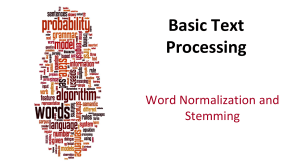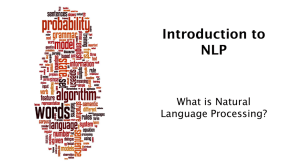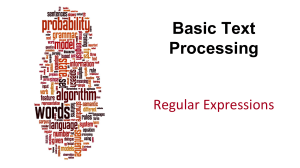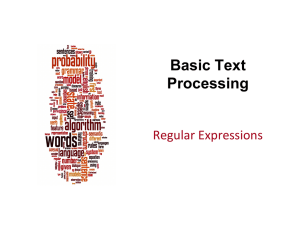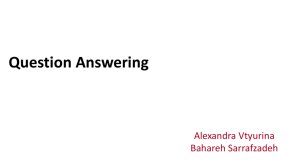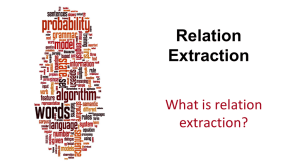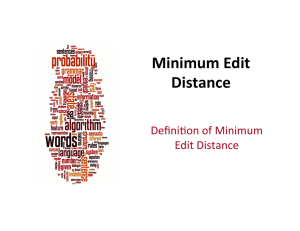PPT for Word Tokenization (14:26)
advertisement
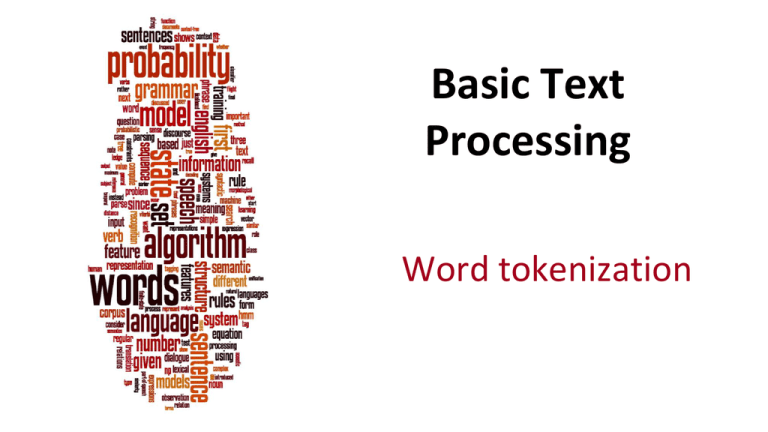
Basic Text Processing Word tokenization Dan Jurafsky Text Normalization • Every NLP task needs to do text normalization: 1. Segmenting/tokenizing words in running text 2. Normalizing word formats 3. Segmenting sentences in running text Dan Jurafsky How many words? • I do uh main- mainly business data processing • Fragments, filled pauses • Seuss’s cat in the hat is different from other cats! • Lemma: same stem, part of speech, rough word sense • cat and cats = same lemma • Wordform: the full inflected surface form • cat and cats = different wordforms Dan Jurafsky How many words? they lay back on the San Francisco grass and looked at the stars and their • Type: an element of the vocabulary. • Token: an instance of that type in running text. • How many? • 15 tokens (or 14) • 13 types (or 12) (or 11?) Dan Jurafsky How many words? N = number of tokens V = vocabulary = set of types Church and Gale (1990): |V| > O(N½) |V| is the size of the vocabulary Tokens = N Types = |V| Switchboard phone conversations 2.4 million 20 thousand Shakespeare 884,000 31 thousand Google N-grams 1 trillion 13 million Dan Jurafsky Simple Tokenization in UNIX • (Inspired by Ken Church’s UNIX for Poets.) • Given a text file, output the word tokens and their frequencies tr -sc ’A-Za-z’ ’\n’ < shakes.txt Change all non-alpha to newlines | sort Sort in alphabetical order | uniq –c Merge and count each type 1945 72 19 5 ... A AARON ABBESS ABBOT ... 25 6 1 5 6 3 .... Aaron Abate Abates Abbess Abbey Abbot … Dan Jurafsky The first step: tokenizing tr -sc ’A-Za-z’ ’\n’ < shakes.txt | head THE SONNETS by William Shakespeare From fairest creatures We ... Dan Jurafsky The second step: sorting tr -sc ’A-Za-z’ ’\n’ < shakes.txt | sort | head A A A A A A A A A ... Dan Jurafsky More counting • Merging upper and lower case tr ‘A-Z’ ‘a-z’ < shakes.txt | tr –sc ‘A-Za-z’ ‘\n’ | sort | uniq –c • Sorting the counts tr ‘A-Z’ ‘a-z’ < shakes.txt | tr –sc ‘A-Za-z’ ‘\n’ | sort | uniq –c | sort –n –r 23243 22225 18618 16339 15687 12780 12163 10839 10005 8954 the i and to of a you my in d What happened here? Dan Jurafsky Issues in Tokenization • • • • • Finland’s capital Finland Finlands Finland’s ? what’re, I’m, isn’t What are, I am, is not Hewlett-Packard Hewlett Packard ? state-of-the-art state of the art ? Lowercase lower-case lowercase lower case ? • San Francisco • m.p.h., PhD. one token or two? ?? Dan Jurafsky Tokenization: language issues • French • L'ensemble one token or two? • L ? L’ ? Le ? • Want l’ensemble to match with un ensemble • German noun compounds are not segmented • Lebensversicherungsgesellschaftsangestellter • ‘life insurance company employee’ • German information retrieval needs compound splitter Dan Jurafsky Tokenization: language issues • Chinese and Japanese no spaces between words: • 莎拉波娃现在居住在美国东南部的佛罗里达。 • 莎拉波娃 现在 居住 在 美国 东南部 的 佛罗里达 • Sharapova now lives in US southeastern Florida • Further complicated in Japanese, with multiple alphabets intermingled • Dates/amounts in multiple formats フォーチュン500社は情報不足のため時間あた$500K(約6,000万円) Katakana Hiragana Kanji Romaji End-user can express query entirely in hiragana! Dan Jurafsky Word Tokenization in Chinese • Also called Word Segmentation • Chinese words are composed of characters • Characters are generally 1 syllable and 1 morpheme. • Average word is 2.4 characters long. • Standard baseline segmentation algorithm: • Maximum Matching (also called Greedy) Dan Jurafsky Maximum Matching Word Segmentation Algorithm • Given a wordlist of Chinese, and a string. 1) Start a pointer at the beginning of the string 2) Find the longest word in dictionary that matches the string starting at pointer 3) Move the pointer over the word in string 4) Go to 2 Dan Jurafsky Max-match segmentation illustration • Thecatinthehat • Thetabledownthere the cat in the hat the table down there theta bled own there • Doesn’t generally work in English! • But works astonishingly well in Chinese • 莎拉波娃现在居住在美国东南部的佛罗里达。 • 莎拉波娃 现在 居住 在 美国 东南部 的 佛罗里达 • Modern probabilistic segmentation algorithms even better Basic Text Processing Word tokenization
